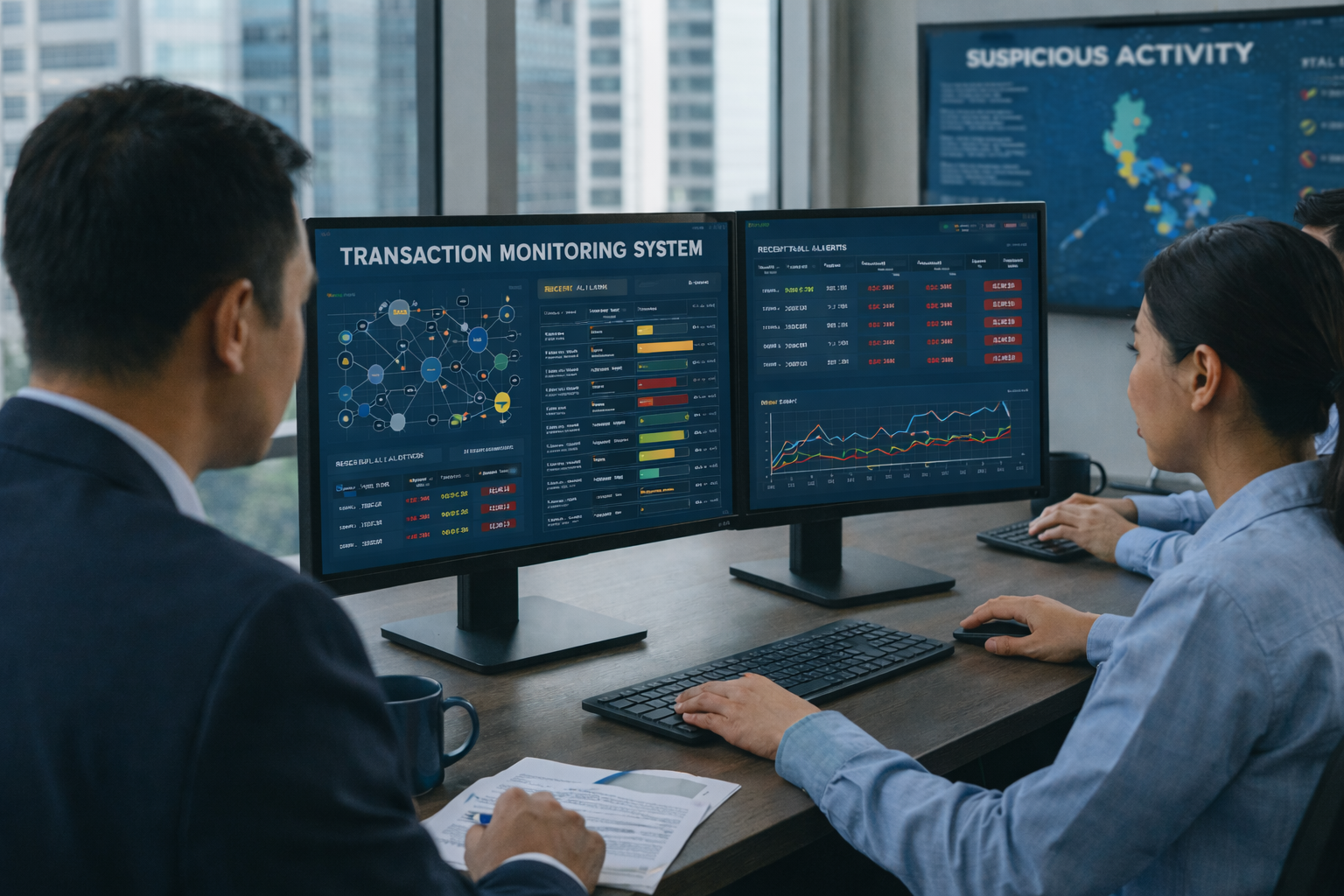Risk Assessment in Transaction Monitoring
.svg)
Ensuring the integrity and security of financial systems is of utmost importance. Risk assessment in transaction monitoring plays an important role. It provides a defense against potential threats and vulnerabilities.
Evaluating the various risks associated with financial transactions is crucial. This can help in identifying and addressing potential issues before they escalate. In this article, we will discuss what is risk assessment. We will also discuss risk assessment in transaction monitoring, among other things.
What is Risk Assessment?
At its core, risk assessment in transaction monitoring is a detailed and systematic process aimed at evaluating potential threats and vulnerabilities that could hamper the integrity and security of business operations.
This comprehensive approach includes recognizing and studying different things that might be risky, like fraud, following the rules, cybersecurity dangers, and operational difficulties. By thoroughly understanding these potential pitfalls, organizations can develop strategies to mitigate or manage the risks effectively. This process is not a one-time event but rather a continuous and dynamic endeavor, adapting to changes in the financial environment and evolving threats.
Risk Assessment and Transaction Monitoring
Risk assessment and transaction monitoring are critical elements in the fight against this illicit practice. Money laundering is about hiding where unlawfully acquired money comes from. It's making it look like the money is from legal sources. Failing to conduct diligent risk assessment can expose businesses to severe financial losses.
Risk Assessment in Money Laundering:
Risk assessment in transaction monitoring involves a thorough analysis of the potential vulnerabilities. These are exploited by criminals seeking to legitimize their illicit gains. For instance, a financial institution might assess the risk associated with a specific type of transaction, customer profile, or geographical region. Failure to identify and address these risks can inadvertently provide opportunities for money launderers to infiltrate the system.
Transaction Monitoring as a Preventive Measure:
Transaction monitoring is the surveillance of financial activities to detect and prevent suspicious transactions. This involves the real-time scrutiny of transactions against predefined risk scenarios. For example, if an individual consistently engages in unusually large transactions or frequent transfers to high-risk jurisdictions without an apparent legitimate reason, it could trigger an alert for further investigation.
Relation between Risk Assessment and Transaction Monitoring
Risk assessment sets the stage by identifying potential vulnerabilities and threats. This proactive process allows businesses to develop a comprehensive understanding of the potential pitfalls that could compromise the integrity of financial transactions.
Once the risks are assessed, transaction monitoring steps in as the vigilant guardian. It's the real-time monitoring system, constantly scanning and scrutinizing financial activities to detect any anomalies or suspicious patterns. It ensures that every transaction aligns with the predefined risk scenarios. By doing so, transaction monitoring acts as the responsive arm of the defense mechanism, ready to intervene and raise alarms at the first sign of irregularities.
The linkage between risk assessment and transaction monitoring is crucial. It forms a continuous feedback loop. As risks evolve, transaction monitoring feeds information back into the risk assessment process. This allows for constant refinement of strategies. Some of the risk analysis techniques in transaction monitoring includes rule-based analysis, anomaly detection, and behavior analysis.
Establishing a Risk Assessment Methodology for Assessing Money Laundering
When it comes to combating money laundering, establishing a robust risk assessment methodology is akin to building a fortress of financial security. This process requires a careful and thoughtful strategy to find, assess, and handle the risks connected to money laundering activities. Here's a human-friendly guide on how to go about setting up a comprehensive risk assessment methodology:
1. Define Objectives and Scope:
Start by clearly defining the objectives of your risk assessment. What are you trying to protect, and against what specific money laundering risks? Decide how broad your assessment should be. Think about things like the kinds of transactions, the customers involved, and the geographic areas that might have risks.
2. Identify Potential Risks:
Conduct a thorough analysis to identify potential money laundering risks within your business operations. This involves understanding the various channels and processes through which illicit funds could be introduced into the system. Consider factors like customer behavior, transaction patterns, and the products or services offered.
3. Gather Data:
Data is the lifeblood of effective risk assessment. Collect relevant and reliable data from various sources. These sources include transaction records, customer profiles, and external intelligence. The more comprehensive and accurate your data, the better equipped you'll be to analyze and identify patterns indicative of money laundering.
4. Develop Risk Criteria and Scenarios:
Establish risk criteria based on the identified risks and potential red flags. Create scenarios that reflect different money laundering typologies and patterns. These scenarios serve as benchmarks against which actual transactions can be compared during the monitoring process.
5. Assess Likelihood and Impact:
Evaluate the likelihood of each identified risk scenario occurring and the potential impact on your business. Think about how many transactions happen, the kind of customers you have, and how well the current controls are working. This step helps prioritize risks for further attention and resource allocation.
6. Implement Controls and Mitigation Strategies:
Once risks are identified and assessed, implement controls and mitigation strategies. These could include enhanced customer due diligence measures, transaction monitoring systems, and staff training programs. The goal is to create a layered defense system that addresses each identified risk effectively.
7. Monitor and Review:
Continuous monitoring and review are integral to a dynamic risk assessment methodology. Regularly revisit and update your risk assessment in response to changes in the financial landscape, regulatory requirements, and emerging money laundering trends. This ensures that your methodology remains agile and responsive over time.
8. Have a Culture of Compliance:
Finally, instill a culture of compliance within your organization. Ensure that all stakeholders, from frontline staff to senior management, understand the importance of adhering to the risk assessment methodology. Regular training and communication efforts can help reinforce a collective commitment to mitigating money laundering risks.
{{cta-guide}}
Aligning Your Money Laundering Efforts with Your Transaction Monitoring Program
Aligning your money laundering efforts with your transaction monitoring program is crucial for creating a cohesive and effective defense against financial crime. To start, set clear goals for your efforts to prevent money laundering (AML). Define what you want to accomplish, like following the rules and protecting financial transactions.
Integrate your AML goals smoothly into your transaction monitoring program. Make sure the criteria and scenarios for spotting potential money laundering align with ongoing transaction monitoring. Customize your monitoring for high-risk areas, whether it's certain transaction types, customer profiles, or geographic regions. This allows for a focused and efficient strategy.
Risk profiling in transaction monitoring is also crucial. Keep your risk profiles dynamic by continuously updating them based on emerging threats, regulatory changes, and the evolving nature of financial crime. Leverage technology and analytics to enhance the capabilities of both your AML efforts and transaction monitoring, employing advanced tools that can analyze large datasets in real time.
Foster collaboration between AML and transaction monitoring teams, promoting communication and information sharing for a holistic understanding of potential risks. Conduct regular training and awareness programs to ensure that your staff is well-equipped to identify and address threats effectively.
Establish feedback mechanisms that allow insights gained from transaction monitoring to inform and improve your overall AML strategy, creating a continuous loop of enhancement and adaptation. In aligning these two critical components, your organization can establish a comprehensive, adaptive, and synergistic approach to combating financial crime.
Transaction Testing
The key to transaction testing is adopting a risk-based approach in transaction monitoring, acknowledging that not all transactions carry the same level of risk. It's about customizing your monitoring efforts to focus more intensively on areas with higher potential risks. Creating scenarios that mimic real-world situations, applying them to your actual transaction data, and analyzing your system's responses are the tangible steps in transaction testing.
Final Thoughts
In conclusion, effective risk assessment and transaction monitoring are essential for businesses to combat money laundering and protect themselves from financial losses. By implementing a comprehensive risk assessment methodology, businesses can identify potential vulnerabilities and develop strategies to mitigate them. Transaction monitoring acts as the vigilant guardian, constantly scanning and scrutinizing financial activities to detect any anomalies or suspicious patterns. It ensures that every transaction aligns with predefined risk scenarios, acting as the responsive arm of the defense mechanism.
To enhance these efforts, businesses can explore Tookitaki's transaction monitoring and AML risk assessment solutions. With their advanced tools and analytics, businesses can analyze large datasets in real time and customize their monitoring efforts to focus on high-risk areas. By aligning their money laundering efforts with transaction monitoring, businesses can establish a comprehensive and adaptive approach to combating financial crime. To learn more about Tookitaki's solutions, visit their website and explore their transaction monitoring and AML risk assessment offerings.
Frequently Asked Questions (FAQs)
{% module_block module "widget_4fde1238-c0dd-4140-858e-6d2199e32b18" %}{% module_attribute "child_css" is_json="true" %}{% raw %}null{% endraw %}{% end_module_attribute %}{% module_attribute "content" is_json="true" %}{% raw %}{"faq_repeater":[{"question":"What is a Customer Risk Assessment?","answer":"A Customer Risk Assessment evaluates the potential risks associated with specific customers, enabling businesses to tailor their security measures based on individual risk profiles."},{"question":"How does risk assessment help in identifying potential risks and vulnerabilities?","answer":"Risk assessment provides a systematic approach, analyzing historical data and current trends to identify potential risks and vulnerabilities before they can be exploited."},{"question":"How can risk assessment help in prioritizing resources and efforts for risk mitigation?","answer":"By categorizing risks based on severity and likelihood, risk assessment enables businesses to allocate resources strategically, focusing on the most critical areas for risk mitigation."},{"question":"What role does data analysis and trend identification play in risk assessment?","answer":"Data analysis and trend identification are the backbone of risk assessment, providing insights into evolving threats and enabling proactive measures to stay ahead of the curve."},{"question":"How can businesses use the findings from risk assessments to improve their transaction monitoring processes?","answer":"The findings from risk assessments can guide businesses in refining and enhancing their transaction monitoring processes, ensuring they remain resilient in the face of emerging risks."}],"previous_button":{"name":"angle-left","unicode":"f104","type":"SOLID"},"next_button":{"name":"angle-right","unicode":"f105","type":"SOLID"}}{% endraw %}{% end_module_attribute %}{% module_attribute "css" is_json="true" %}{% raw %}null{% endraw %}{% end_module_attribute %}{% module_attribute "label" is_json="true" %}{% raw %}null{% endraw %}{% end_module_attribute %}{% module_attribute "module_id" is_json="true" %}{% raw %}145737358967{% endraw %}{% end_module_attribute %}{% module_attribute "schema_version" is_json="true" %}{% raw %}2{% endraw %}{% end_module_attribute %}{% module_attribute "style" is_json="true" %}{% raw %}{"slider":{"arrow_color":{"color":"#0C343D","opacity":100}}}{% endraw %}{% end_module_attribute %}{% module_attribute "tag" is_json="true" %}{% raw %}"module"{% endraw %}{% end_module_attribute %}{% end_module_block %}
Experience the most intelligent AML and fraud prevention platform
Experience the most intelligent AML and fraud prevention platform
Experience the most intelligent AML and fraud prevention platform
Top AML Scenarios in ASEAN

The Role of AML Software in Compliance

The Role of AML Software in Compliance










